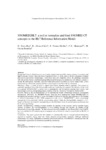SNOMED2HL7: a tool to normalize and bind SNOMED CT concepts to the HL7 Reference Information Model

View/
Use this link to cite
http://hdl.handle.net/2183/22810
Except where otherwise noted, this item's license is described as Atribución-NoComercial-SinDerivadas 3.0 España
Collections
- Investigación (FIC) [1683]
Metadata
Show full item recordTitle
SNOMED2HL7: a tool to normalize and bind SNOMED CT concepts to the HL7 Reference Information ModelAuthor(s)
Date
2017-10Citation
Pérez-Rey D, Alonso-Calvo R, Paraíso-Medina S, et al. SNOMED2HL7: a tool to normalize and bind SNOMED CT concepts to the HL7 Reference Information Model. Comput Methods Programs Biomed. 2017; 149: 1-9
Abstract
[Abstract] BACKGROUND: Current clinical research and practice requires interoperability among systems in a complex and highly dynamic domain. There has been a significant effort in recent years to develop integrative common data models and domain terminologies. Such efforts have not completely solved the challenges associated with clinical data that are distributed among different and heterogeneous institutions with different systems to encode the information. Currently, when providing homogeneous interfaces to exploit clinical data, certain transformations still involve manual and time-consuming processes that could be automated.
OBJECTIVES: There is a lack of tools to support data experts adopting clinical standards. This absence is especially significant when links between data model and vocabulary are required. The objective of this work is to present SNOMED2HL7, a novel tool to automatically link biomedical concepts from widely used terminologies, and the corresponding clinical context, to the HL7 Reference Information Model (RIM).
METHODS: Based on the recommendations of the International Health Terminology Standards Development Organisation (IHTSDO), the SNOMED Normal Form has been implemented within SNOMED2HL7 to decompose and provide a method to reduce the number of options to store the same information. The binding of clinical terminologies to HL7 RIM components is the core of SNOMED2HL7, where terminology concepts have been annotated with the corresponding options within the interoperability standard. A web-based tool has been developed to automatically provide information from the normalization mechanisms and the terminology binding.
RESULTS: SNOMED2HL7 binding coverage includes the majority of the concepts used to annotate legacy systems. It follows HL7 recommendations to solve binding overlaps and provides the binding of the normalized version of the concepts. The first version of the tool, available at http://kandel.dia.fi.upm.es:8078, has been validated in EU funded projects to integrate real world data for clinical research with an 88.47% of accuracy.
CONCLUSIONS: This paper presents the first initiative to automatically retrieve concept-centered information required to transform legacy data into widely adopted interoperability standards. Although additional functionality will extend capabilities to automate data transformations, SNOMED2HL7 already provides the functionality required for the clinical interoperability community.
Keywords
Interoperability
SNOMED CT HL7
Normalization
Data integration
SNOMED CT HL7
Normalization
Data integration
Editor version
Rights
Atribución-NoComercial-SinDerivadas 3.0 España
ISSN
0169-2607






